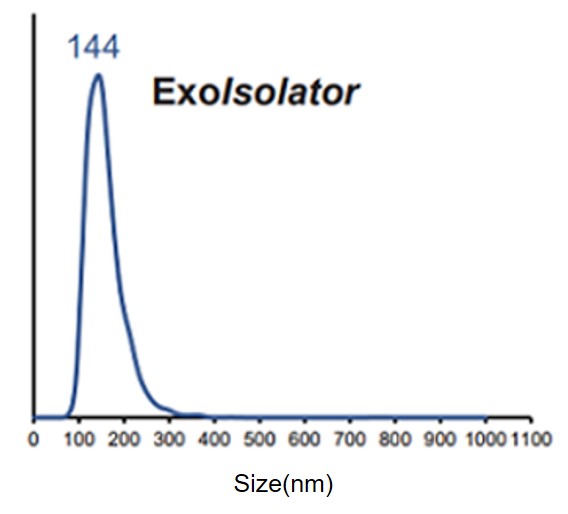ExoIsolator Exosome Isolation Kit

Exosome Isolation Kit
- Easy to use, no technique required
- Recovery rate equivalent to ultracentrifugation
- Filter holder is reusable
-
Product codeEX10 ExoIsolator Exosome Isolation Kit
| Unit size | Price | Item Code |
|---|---|---|
| 3 tests | $597.00 | EX10-10 |
| 3 tests | ・Filter Holder ・Isolation Filter ・Tweezers |
×1 ×3 ×1 |
|---|
Description
ExoIsolator Exosome Isolation Kit can collect exosomes from cell supernatants with a recovery rate equivalent to the ultracentrifugation(UC) method. Science ExoIsolator Exosome Isolation Kit requires only the filtration procedure, unlike the UC, exosomes are obtained quickly without any complicated operations.
Manual
Technical info
ExoIsolator Exosome Isolation Kit includes Filter Holder and Isolation Filter can collect exosomes from cell supernatant by adding PBS to the filter surface after filtration. The exosomes recovery rate is high and easy to use, no technique is required during the whole process. [Patent applied]

Feature 2: Recovery rate equivalent to ultracentrifugation
Ultracentrifugation is the most commonly used method to isolate exosomes. We isolated the exosomes from the supernatant of HEK293S using both of ultracentrifugation method and the ExoIsolator method. The particle size distribution (Fig. 1), the number of particles (Fig. 2(a)) and the expression level of exosome markers (Fig. 2(b)) of the isolated exosomes were tested and compared. The results showed that the ExoIsolator recovered exosomes with the same particle size distribution and the number of particles as the ultracentrifugation method, and the amount of exosome marker expression per protein was higher, indicating that ExoIsolator recovered exosomes with higher purity than the ultracentrifugation method.

Fig. 1 Nanoparticle size of isolated exosomes

Fig 2. Nanoparticle number(a) and expression level of exosome markers(b)
Kit contents
This kit contains Filter Holder x 1, Isolation Filter x 3, Tweezers x 1. The Filter Holder can be reused after autoclaving.

In addition, the Isolation Filter is also sold separately in a pack of 10 pieces.
Please refer to this webpage: Code EX11 ExoIsolator Isolation Filter.
References
| Reference No. | Samples | Citations |
|---|---|---|
| 1) | Culture medium from Luva Cell |
Y. Wang, A. Chen, "Mast cell-derived exosomal miR-181a-5p modulated trophoblast cell viability, migration, and invasion via YY1/MMP-9 axis", J. Clin. Lab. Anal., 2022, doi:10.1002/jcla.24549. |
Q & A
-
Q
What is the size of the isolated exosomes?
-
A
The size of isolated exosomes is approximately 100-200 nm.
(Reference)
The size distribution of isolated exosomes from cultured medium of HEK293S cells.

-
Q
What is the sample amount that can be isolated with one filter?
-
A
For cultured medium, we recommend 25 ml.
If the sample volume increases, the filtration time should also increase.
For example, 25 ml of the cultured medium of HEK 293 cells(11.2 μg protein) usually takes approximately 5- 10 minutes for filtration.
The filtration time depends not only on the sample volume but also on the amount of exosome and protein contained in the sample.
-
Q
How many exosomes can be isolated from the medium?
-
A
The exosome yield may vary depending on the cell type and the condition of cell culture. As an example, we have recovered exosomes from 25 ml of culture supernatant of HEK293S cells (shaking culture) is as below.
Recovered protein (μg)
Number of isolated exosomes (particles)
11.2 (SD±2.09)
6.0E+09 (SD±1.0E+9)
* Protein recovery rate is tested with BCA method, the number of particles is tested with NTA method.
-
Q
What is the recovery rate of isolated exosomes using ExoIsolator?
-
A
The recovery rate may vary depending on the sample.
As an example, the recovery rate of commercially available bovine milk-derived exosomes using ExoIsolator is as below.Protein recovery rate (%) Nanoparticle recovery rate (%) 34.6 (SD±3.9) 38.3 (SD±8.3) * Protein recovery rate is tested with BCA method, the Nanoparticle recovery rate is tested with NTA method.
-
Q
Can I isolate exosomes from the cell culture supernatant containing serum?
-
A
We do not recommend the use of medium containing serum. If the medium containing serum is used, the cell culture supernatant will contain a mixture of the exosome from cells and the exosomes from serum, which may affect the experiment after exosome purification.
-
Q
Can I store the isolated exosomes for a long period of time?
-
A
According to the following reference (in Japanese), the isolated exosomes can be stored at 4°C for one to six months. For long-term storage, store at -80℃. To avoid freezing and thawing as much as possible, subdivided into small volumes is recommended.
Reference: Yusuke Yoshioka, Ochiya Takahiro(2020), Guide to Exosome Experiment, ISBN: 978-4-7581-2246-7
-
Q
How to check the pressure of a aspirator?
-
A
You can check the aspiration pressure with a pressure gauge.
If you don't have a pressure gauge, you could aspirate a PBS solution, and adjust the aspiration pressure based on the processing time.
Aspiration filtration of 25 ml PBS at -25kPa usually takes about 30 seconds.To maintain the data reproducibility, we recommend checking the aspiration pressure with a pressure gauge before isolating the exosomes.
-
Q
I have some trouble isolating exosomes(low recover rate). What is the possible reasons?
-
A
The possible reasons are as follows:
1. If the filtration pressure is too high, the recovery rate of exosomes may be significantly reduced. The recommended pressure is -25 kPa or lower.
2. The Isolation Filter has an upper surface and bottom surface. Make sure the Isolation Filter is properly set up, for more details, please refer to the manual or video on this webpage.
3. In order to recover all the exosomes on the Isolation Filter, use PBS to flush the whole upper surface of the Isolation Filter several times, for more details, please refer to the manual or video on this webpage.
-
Q
After a period of time for aspiration, it seems like the filter is clogged. What are the possible reasons?
-
A
The possible reasons are as followings.
1. If the sample volume is too large or the protein concentration in the sample is too high, filtration may take longer.
Here is the sample volume and filtration time when processing HEK293S cell supernatant
25 ml (11.2 μg protein): 5-10 minutes
50 ml (22.4 μg protein): 30-60 minutes
2. If the aspiration pressure is too low, may take a longer time.
Aspiration pressure and filtration time when processing HEK293S cell supernatant (25 ml)
Aspiration pressure at -25 kPa: 5-10 minutes
Aspiration pressure at -10 kPa: 10-20 minutes
3. There might be too many impurities in the sample that clogged the filter.
Please filter the sample with a 0.22 μm filter before the isolation process.
Handling and storage condition
| Store at room temperature. |

















